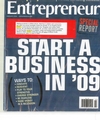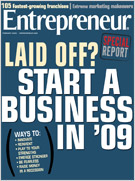Year of the Bootstrapper
Here are some tips for growing without an external cash infusion.

The term organic may take on a new context this year, as entrepreneurs turn to natural growth rather than loans or investors for expansion. Growing without an external infusion of cash can be a challenge, demanding ingenuity and creativity.
Bonnie Marcus, 37, saved money while starting her Westport, Connecticut, stationery company, Bonnie Marcus Collection, in 2002 by creating samples of her work and sending them to magazine editors. The low-cost approach worked: She landed mentions in New York magazine and Modern Bride, helping her secure orders from stationery stores including Bloomingdale's and Saks Fifth Avenue. Even as her business broke the $1 million mark in 2007, Marcus found other inexpensive ways to grow: She licensed her designs to Kodak for photo cards and produced holiday cards for a Beverly Hills PR firm, gratis. The result? Model and actress Molly Sims placed her holiday card order with Marcus. Pitching products in unlikely places, listening to retailers and consumers, and other low-priced strategies fueled the growth of Los Angeles-based Zorbitz, a lucky-karma-beads jewelry line. Daughter and mother Robin Sydney, 25, and Marian Heymsfield, 54, cut down costs whenever possible by tailoring their products to retailers' needs and buying limited quantities. Started in 2003, Zorbitz continually tops gift sales at Whole Foods, surpassing $2 million in sales in 2008.
For Theresa Rogers, 53, whose 1989 purchase of Greenwich, Connecticut-based Horseneck Wine and Liquors came during the worst recession since the Great Depression, growing the business meant pouring every penny of profit back into her business and creating opportunities in the marketplace. Rogers donated to local charity events, conducted wine-tasting parties in customers' homes and got to know local restaurateurs and retailers. Her hard work paid off: She went from a small $500,000-a-year wine shop to the largest collection of fine and rare wines in the state and $5 million in annual sales.
By Scotty Reis |
